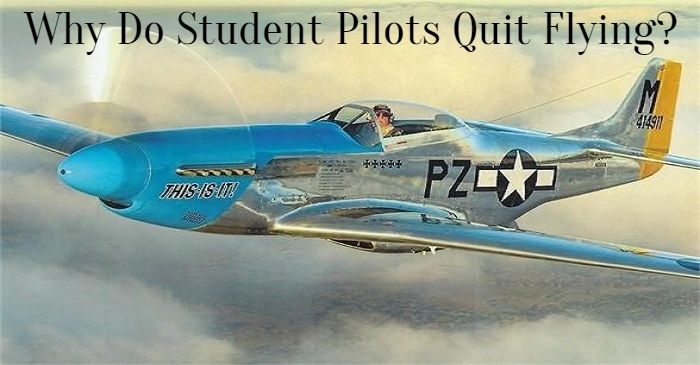
I cannot imagine a life without airplanes being involved. Especially my brother’s WWII P 51 D Mustang. “My Sweet Mary Lou.” I hear about people that start learning to fly and give up. Some of whom have spent much time and money. I must wonder, Why Do Student Pilots Quit Flying? Quitting learning to fly is a mistake. Let’s discuss the reasons.
Why Do Student Pilots Quit Flying?
Most student pilots simply lose motivation. Some find they have found that the cost is too great, while the lack of quality instruction discourages others. The time needed to learn to fly can deter some as well as the hours of study required to pass the exams.
Why Do Student Pilots Quit Flying?
1. Motivation
The key to anything you want in life is desire. You must have an unwavering desire that you will succeed. When you set your mind that you will overcome any obstacle that may stand in your path, you will become a pilot. The desire is vitally important.
This mindset will create the motivation to learn to fly. If you stay focused on the achievement of your pilot certificate your success is imminent.
It is interesting that many students drop out but later come back with renewed motivation and finish training. I was one of those students. I quit in March 1973 after 23 hours and started again on November 15, 1974.
On the 21st day of December 1975, I passed my private pilot check ride. 5 weeks of study and weather permitting flying in Idaho Falls, ID. at RED BARON FLYING SERVICE, home of the famous RB 51. The counter-rotating P 51 championship racer.
The absolute clincher for me to continue flight training was the opportunity to fly in the “Undertaker,” a WWII P 51D Mustang owned by Red Baron Flying Service and Ed Browning, also the owner of the RB51 and the F104.
Captain George Roberts, a WWII P 51 Pilot/mechanic took me for a 300 mph low-level ride across the lava fields east of the airport. I was instantly obsessed with power and speed in the air and a craving for more. Nothing could stop me at that point.
The motivation comes from the insatiable desire to accomplish that one thing that gives you the greatest freedom that exists. The privilege of flight.
2. Bad Instructors.
I hate to think that, but it is true. There are some instructors that just do not care to teach and students quickly lose interest in the idea of flying.
This is unfortunate in two ways as it discourages some possibly great pilots from their goals and it gives instructors a bad name.
The other obstacle that can arise is a failure to have a structured flight training syllabus. This leaves pilots not knowing what they expect of them in the training session. Therefore, they don’t know what to study.
Both problems leave students frustrated and alone and, inevitably, they quit.
Any check-ride failures point directly to poor instruction. A failure any time when flying is devastating to a pilot. Many students quit, and that is a total B.S. outcome and completely avoidable.
The solution to this is obvious, so choose the avenue for training that suits you. Pick a good flight school or instructor that you like and who has a reputation for teaching.
3. Time And Money.
Flying is expensive and flight training today is ridiculously expensive. Finding the time and money for training is not an easy task.
A great deal of sacrifice and planning is required to be ready, so one must do the homework. Budget your flight time and stay focused on your goal.
This is the fulfillment of a lifetime and it is one thing that you must see through to the end. You miss far too much if you quit. You will forever wish you had finished.
There are grants, scholarships, loans, and airline training programs that pay for training at reasonable interest rates, (cheap,) There are ways to get what you want if you look in the right places.
Put yourself out there with other pilots and networks. You might be the pilot that gets that Part 135 VFR job at 500 hours.
4. Making Time For Study And Self-Doubt.
Learning to fly is much more than just flying an airplane, it requires hours and hours of study to cover all the topics in the Private Pilot Syllabus. With a quality Flight and Ground Instructor, this part of the training will be segments that cover each lesson.
This provides students with time to study previous lessons and brief themselves on the next lesson.
If a student follows the training as we lay it out, the study time will be far less overwhelming and this adds to people’s self-confidence, which relieves a great deal of self-doubt.
If you have doubts about flying, talk it over with your instructor and give them the chance to address your personal issues.
Ground School will cover all the information in depth, which gives a student time for questions and will help with confusing material.
5. Medical.
Go see your family doctor and tell the “Doc” your intentions and get a physical. If you have any problems, they will appear and you can correct any issues before seeing an Aviation Medical Examiner (AME),
The FAA takes a dim view of reported health issues and if you address your medical problems beforehand, you will save maybe months of frustration dealing with the FAA. You should read the Private Pilot requirements here.
Conclusion.
I understand leaving flight school behind because I left it behind with 26 hours and had completed most of the work. My time in college was finished, and it was time to go home.
I made myself believe I was wasting my time because there were truly no jobs because of an enormous number of military pilots returning from Viet Nam and even CFI positions were scarce.
As stated above, I finished 2 years later with a renewed interest, and I am eternally grateful that I had the chance.
Never QUIT. Fly Safe.
